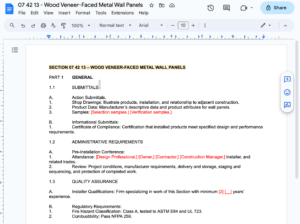Are you an architect or someone passionate about construction projects? Then you’ve likely heard the terms “Long Form” and “Short Form” when it comes to 3-Part Specifications. But what do they really mean, and how do they affect your projects?
Let’s break it down in a way that everyone can grasp.
Long Form Specs: The Encyclopedia of Construction Details
Imagine you’re working on a large-scale construction project—a towering skyscraper or a sprawling commercial complex. Precision and thoroughness are non-negotiable. That’s where Long Form Specifications come into play.
Long Form Specifications, as the name suggests, are detailed, comprehensive documents. They leave no stone unturned, serving as the encyclopedias of construction information.
Here’s what they include:
1. Materials
Long form specs dive deep into materials. They specify the types, quality, and standards of materials to be used, ensuring every element of your project meets exacting requirements.
2. Methods
These specs outline the precise methods and techniques to be employed during construction. It’s like having a step-by-step guide for your project, ensuring consistency and quality.
3. Quality Standards
Long form specifications are all about maintaining quality. They establish stringent quality control standards to ensure that your project meets industry benchmarks.
4. Installation Procedures
They go as far as detailing installation procedures. These are crucial for intricate projects, ensuring that everything is installed correctly, preventing costly mistakes.
Long form specs are your best friend when you need to ensure every detail is meticulously planned. They’re ideal for complex, high-stakes projects where precision is paramount.
Short Form Specs: The Express Ticket to Efficiency
Now, let’s switch gears to a different scenario—a smaller project, a home renovation, or something that needs to be done swiftly and efficiently. Enter Short Form Specifications.
Short form specs are like the Cliff’s Notes version of their long form counterparts. They’re concise, covering the essentials without delving into the nitty-gritty. Here’s what you get:
1. Essentials
Short form specs provide you with the core information. You’ll find the basic requirements, materials, and methods needed to get the job done.
2. Streamlined
These specs are all about streamlining the process. They eliminate the extensive details, perfect for projects where time is of the essence.
3. Efficiency
Short form specifications are your express ticket to efficiency. They help you get the project off the ground quickly without getting bogged down in details.
So, when should you use Short Form Specifications? They’re ideal for smaller projects, renovations, or when you need to expedite the construction process.
In conclusion, the choice between Long Form and Short Form 3-Part Specifications depends on finding the right balance between detail and efficiency for your specific project. Whether you’re building a towering skyscraper or renovating a cozy cottage, understanding these specifications will help you navigate the world of construction with confidence and expertise.
Happy building!



